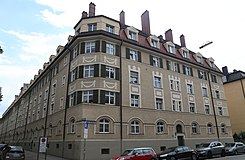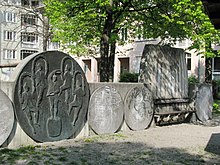Tulbeckstrasse
| Tulbeckstrasse | |
|---|---|
| Street in Munich | |
| Corner house Tulbeckstrasse 33 | |
| Basic data | |
| State capital | Munich |
| City district, part of town | Schwanthalerhöhe , Westend |
| Name received | 1878 |
| Cross streets | Parkstrasse, Ligsalzstrasse, Ganghoferstrasse, Geroltstrasse, Bergmannstrasse , Trappentreustrasse |
| Numbering system | Orientation numbering |
| use | |
| User groups | Pedestrian traffic , bicycle traffic , car traffic |
| Technical specifications | |
| Street length | 700 m |
The Tulbeckstraße is a street in Munich and is located west of downtown in the district Schwanthalerhöhe . It leads from Parkstrasse in the east to Trappentreustrasse in the west. It was named in 1878 after the Munich patrician family Tulbeck, from which the Freising Prince-Bishop Johann IV. Tulbeck (term of office: 1453–1473) comes.
location
Tulbeckstrasse is located in the Schwanthalerhöhe district and here in the Westend district, a classic working-class district with cooperative buildings from around 1900. Tulbeckstrasse is centrally located in the district and runs in an east-west direction over a length of a good 700 meters. The northern parallel streets are Schwanthalerstraße and Westendstraße , the southern Gollierstraße with Gollierplatz .
Course of the road
Tulbeckstrasse branches off from Parkstrasse in the east and, unlike Gollierstrasse, has no connection to Theresienhöhe . In the west, it joins Trappentreustraße at the height of the Trappentreutunnel.
Tulbeckstrasse is characterized by apartment buildings numbered from 1 to 57 and 2 to 52 from east to west. The original tenement houses with the low house numbers in the east are older (1882–1889) and predominantly influenced by the neo-Renaissance style (2a, 3, 5 to 8, 11, 22), the high house numbers in the west are younger (1901–1924) and predominantly influenced by the style of the German Renaissance and Art Nouveau (33, 41 to 52, 55, 57).
history
In 1862 the Drexler barrel factory settled on the site. It had the address Westendstraße 95. Along its southern end a street was formed which has been called Tulbeckstraße since 1878 and which was gradually built from east to west.
cartography
In the 14th edition of the Brockhaus Konversations-Lexikons from 1891, the street is completely marked and already built on beyond Bergmannstraße .
Transport links
There is no direct connection between Tulbeckstrasse and local public transport. The nearest underground stations are Schwanthalerhöhe and Heimeranplatz , the latter is connected to the S-Bahn network in addition to the nearby Munich Donnersbergerbrücke train station. The bus line 134/53 can be reached via the Schwanthalerhöhe stop , the bus line 133/53 via the stop Gollierplatz and the tram line 18/19 via the stop Schrenkstraße .
Architectural monuments
Between 1880 and 1890 four-storey apartment buildings of medium to low standards with open courtyards and low rear buildings were built along Tulbeckstrasse, which were mostly occupied by commercial enterprises. This includes, among other things, the five houses that were built as a workers 'home by the Catholic workers' association in Munich-West , which was founded in 1888 in Ganghofer- / Tulbeckstraße. In 1911/12 the residential complexes on both sides of Tulbeckstrasse with house numbers 41 to 51 were built, which had been commissioned by the Munich-West building cooperative. Since the late 1970s, Tulbeckstrasse has been fully integrated into the Westend district redevelopment.
A total of 23 monuments erected between 1882 and 1924 (number = D-1-62-000-7025 to -7047) are located directly on Tulbeckstrasse, predominantly in the Neo-Renaissance, German Renaissance and Art Nouveau styles.
Tenement houses by Kastulus Binderberger (2a), Georg Schillinger (3), Johann Grimm (5), Franz Buchold (6, 8), Karl Albert (7), Heinrich Hermann (11), Georg Müller (22), Ludwig Naneder (33 ), Jakob Heilmann and Max Littmann (41, 42, 43, 44, 45, 46, 47, 48, 49, 50, 51) and Leonhard Moll (52)
Other notable houses
- Tulbeckstrasse 4: The seat of the publishing house “Das Freie Buch” and the associated printing company, the “Publishing house for the promotion of scientific worldview - Stephan Eggerdinger Verlag” as well as numerous left-wing groups (e.g. August-Kühn-Verein , Arbeiterbund für den Wiederaufbau der KPD, Association for the Promotion of Scientific Weltanschauung eV) is also known as the “house with the red flag” and has been the center of working-class culture and the Munich workers' movement since the early 1970s. The house is currently represented in the Munich media due to an eviction action by the city.
- Tulbeckstrasse 12: In the 1970s, this address became known as a dormitory for illegal migrant workers “from Istanbul to Pakistan”.
- Tulbeckstrasse 19: The building houses the “Kinderhaus Lummerland e. V. ".
- Tulbeckstrasse 26/28: In the inner courtyard of Tulbeckstrasse 26 to 28 there is a memorial in memory of the Drexler barrel factory. The "Mechanical barrel factory Joh. Drexler & Sohn" (1862–1979) was demolished in the course of the redevelopment of the district. In their place, the state capital of Munich had 191 apartments built by the Munich Society for Urban Renewal and Gewofag in 1985/86 .
- Tulbeckstrasse 27 (/ 29): The Catholic workers 'association Munich-West, founded in 1888, built the so-called “workers' home”, later called “Rupertusheim”, on Ganghoferstrasse / Tulbeckstrasse. The building on Tulbeckstrasse housed a large festival and theater hall from 1896, which - among other things, the “Dramati Club Alpenröserl e. V. ”, the“ Dramatic Club Munich-West ”and the“ Münchner Caritas stage ”- served as a venue until the early 1980s. From 1952, the Carlton Filmgesellschaft , headed by Günther Stapenhorst, moved into the former Rupertusheim and converted the residential building with a restaurant into a studio with three recording halls and a total of 1400 m². Numerous well-known feature films were made there, for example Im Weisse Rößl (1952) , The Flying Classroom (1954) , Königswalzer (1955) and Little Man - Very Big (1957) . The operation went to the tv star production and studio company mbH and the Lisa Film GmbH (for example our doctor is the best , 1969). In addition, Tulbeckstrasse 27 housed the renowned Munich gentian distillery & liqueur factory L. Eberhardt, which had been founded in 1879, until it was expropriated by the National Socialists in 1938.
- Tulbeckstraße 31: The old people's and service center has been located in this building on the corner of Geroltstraße since 1983. The center is also the seat of the “Diakoniestation Westend des Evangelischen Verein München Westend eV” as well as the rehearsal room of the Bürger-Sänger-Zunft München e. V.
- Tulbeckstrasse 42 to 50: The residential complex was built in 1910/1911 on behalf of the "Munich-West Building Cooperative". Tulbeckstrasse 44 also served as the “Genossenschaftsheim” restaurant, where the local group of the “ Workers-Cyclists Solidarity ” met for many years . In the 1980s, the “Genossenschaftsheim” became the left-wing alternative pub “Beim Knittel”. Since 1991 the administrative headquarters of the "Housing Cooperative Munich-West eG" have been located in the premises. The “Association for Intergenerational Living with the Munich-West Housing Cooperative e. V. “is located on the ground floor at Tulbeckstrasse 48.
- Tulbeckstraße 57: A branch of the Stadtsparkasse Munich is located in this building .
literature
- City of Munich, KulturGeschichtsPfad 8: Schwanthalerhöhe ( PDF file )
Web links
Individual evidence
- ↑ Munich city map, lithograph 1891 on machinatemporis.de
- ↑ Faces of the West End (PDF file)
- ↑ City portal Munich: Architectural monuments - Tulbeckstrasse
- ↑ Homepage , article in the evening newspaper on the status of the eviction action from October 20, 2017
- ↑ Franziska dark, Gabriella Stramaglia-Faggion, the history of foreign players in Munich , 2000, p 152; Natalie Bayer, Crossing Munich , 2009, p. 60
- ↑ Schwanthalerhoehe district: On historical traces
- ↑ Raise the curtain in Sendling!
- ^ Georg Roeber, Gerhard Jacoby, Handbuch der Filmwirtschaftlichen Mediengebiete , 1973, p. 352
- ↑ Article "Bavaria's Famous Brand". The most successful producer of the gentian schnapps was Jude, in: Jüdische Allgemeine from May 15, 2014
- ↑ State capital Munich, KulturGeschichtsPfad 8: Schwanthalerhöhe ( PDF file )
Coordinates: 48 ° 8 ′ 12 ″ N , 11 ° 32 ′ 26 ″ E














